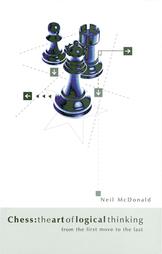Chess: The Art of Logical Thinking
July 31, 2006 at 12:01 am | Posted in Chess | Leave a comment
I finished reading Neil McDonald’s Chess: The Art of Logical Thinking (2004) last weekend. This is the first chess book I’ve EVER read from cover to cove. Hooray for me! What initially attracted me to this book were the numerous board diagrams — anywhere from 8 to 15 per game — and that each moved is annotated. Most of the annotations were complete sentences as opposed to standard fare of a list of variations.
From Adams-Salov:
5 . . . e5
The defining move of the Sveshnikov Variation. At first glance it makes a lot of sense as Black:
- establishes his pawn centre and negates white’s space advantage
- drives the enemy right from its strong base on d4
- clears the way the development of his king’s biship with gain of time, as Nxc6 bxc6 would only strengthen black’s centre.
6 Ndb5
This, however, is a very testing reply. The downside of Black’s last move is that he left himself with a backward pawn on the d file.
For me, a beginner who has only been studying chess seriously for three-months or so, McDonald’s ability to enter a chess master’s mind was enlightening to a patzer like me.
From Kovacevic-Seirwan:
12 a4
Of the next few moves it becomes clear that white has run out of dynamic ideas and he is trying to achieve a draw by blocking everything up. His pawn structure loses all flexibility, he weakens the e5 square and he removes all obstacles (he would call them ‘targets’!) from teh sights of the black biship on g7. On the otherhand he hopes that the lack of open lines will prevent Black from making any winning breakthroughs — after all, it is White who controls the only open file on the board with his rook on h1.
Also, as a beginninger, my historical knowledge of the game is limited to the names of Fischer, Spassky, Kasparov and Karpov. McDonald’s book provided me with my first glance of Adams, Anand, Tal and others as well as the limited ability (on my part) to witness and try to udnerstand all 30 games from these variosu masters.
Of course there were silly annoatations such as these after 1 e4:
Just as Dracula would be helpless if he were unable to escape from his coffin, or a butterfly could never emerge unless it discarded its catepillar husk, so too the pieces cannot at all perform unless the pawns are first moved out of the way. (Huebner-Portish)
Just as a house needs to be constructed on a firm foundation, so too does every plan for White need a solid beginning. The first stone to be laid in this case is 1 e4. (Nunn-Sokolov)
But the greatest harm this type of annotation did was bring a slight smile to my face.
Most of the games are together at Chessgames.com.
Women in Chess (Part III)
July 30, 2006 at 12:01 am | Posted in Chess | Leave a commentContinuing the Women in Chess thread — adding games to the faces. Below are women on Page 3.
Previous posts are: Women in Chess (Part I) and Women in Chess (Part II)
Chess Masters On The Street
July 29, 2006 at 12:01 am | Posted in Chess Photos | 2 Comments
Photograph by vir2alcitizen
Chblurking
July 28, 2006 at 12:01 am | Posted in Chess | Leave a commentKing of Spill writes:
I finally got my Circles pay off in a standard game! I was extra focused on every threat on every move, both mine and my opponents, which helped. Too many times in the past I have been surprised by my opponents response. Anyway, t was nice to win and play well, and this may be my best of the year :).
Congratulations! It’s nice to see that these exercises will pay off. Sciurus posts a win as well.
The Expert Mind by Philip Ross is online now which I mentioned earlier.
Blue Knight has finished Circle One and wrote a little piece about the Grand Prix Attack.
Meanwhile Mark Weeks writes about the Reti Opening, 1. Nf3; takchess, King’s Gambit; The Kenilworthian, the Spanish Four Knights.
A new blogger, Transformation, is amongst us at Chess Improvement.
Generalakia is back, blogging regulary, and churning through on CTS.
Immigration issues hit the chess world. You can read about it at Boylston Chess Club (BCC) or The 64 Square Jungle. Oh, and a big clap of hands for the BCC for suprassing 50,000 bong hits.
J’adoube appears not to have had a good time in Kansas — there’s a Wizard of Oz joke here somewhere.
Sarah has a letter by Edwin Lawrence Godkin which points to the absurdity of celebrity worship from the 1850s which sounds hauntingly familiar today. If you read the letter, Kossuth was a renowened Hungarian revolutionary and Jenny Lind, a popular singer.
And, finally, Tempo does some math and my brain hurts.
BDO Opening
July 27, 2006 at 6:01 am | Posted in Skittles | Leave a commentAs mentioned earlier, here’s a picture of Brady David Odell.

Women in Chess (Part II)
July 27, 2006 at 12:01 am | Posted in Chess | Leave a commentContinuing the Women in Chess thread. Below are women on Page 2.
Anna Dergacheva*
* I couldn’t find any games for Anna Dergacheva. I would appreciate it if someone could direct me to a few.
Winning Isn’t Everything
July 26, 2006 at 12:01 am | Posted in Chess | 34 Comments
Photograph by LeChatMachine
Should children be awarded prizes for winning chess tournaments in elementary school? This question was posed by DG back in May. My response was emphatic:
I can’t disagree with you more. A chess tournament in an elementary school should be fostering life-long chess adherents. For 1st through 3rd grades any and all games should be instructive and not competitive. There is plenty of time for competitive chess. And, if a child is that good, there are definitely competitive avenues for that child to explore.
Then a few weeks later, Dennis Monokrousos picked up the thread in his blog disagreeing with my statement. I’ve just found his post and the comment time has past, so I’ll comment here.
I’ve coached baseball and soccer to children from the ages of 5 to 8 and though I’m no expert, I’ve seen a few things. The kids keep score no matter what and they keep score badly. Even if the parents don’t recognize the winner, the children try to. If the game is close, both teams go home thinking they won. Is that so bad? But I’ve seen coaches foster competition and I watch as the children begin not to enjoy the activity, move on to dread the sport and then quit playing.
At a elementary school chess tournament, the kids will no doubt count their own wins and loses. They might even know who is the best. Let them decide this on their own. If one child succeeds wildly, have them go to the local chess club to play, but please keep the competition out of the schools.
Foster a love of chess to all children. If you pass out three trophies out of 15 participants, you have the distinct possibility of making 12 children hate chess.
Alfred Kohn, writer and child psychologist, writes:
Consider one of the first games our children learn to play: musical chairs. Take away one chair and one child in each round until one smug winner is seated and everyone else has been excluded from play. You know that sour birthday party scene; the needle is lifted from the record and someone else is transformed into a loser, forced to sit out the rest of the game with the other unhappy kids on the side. That’s how children learn to have fun in America.
A paper prepared by Dr. Cynthia E. Johnson, a Human Development Specialists of the North Carolina Cooperative Extension Service, said:
Research says that activities for young children should be noncompetitive but should promote the practice of a limited set of skills. Children this age group need to win often. Their short attention spans keep them from understanding complex rules. They lack the competitive rivalry skills to compete. They cannot develop strategies to defeat another. They aren’t ready for physical competition and have difficulties functioning in team situations. Nine- to 12-year-olds understand competitive play. They have better understanding of their personal capabilities and enjoy competitive games and activities where one wins and one is defeated. Games offer the experience of competence. Twelve-year-olds are candidates for competition. Children 13 and older fare better in competitive activities.
Rae Pica, children’s physical activity specialist, writes:
Of course, you may think the goal of winning would be enough to propel children into performing their best. But young children aren’t cognitively ready to make that connection. They attribute winning or losing to ability, not effort. Nor are they emotionally ready to handle the pressure of playing mistake-free games. And they’re not physically ready to play without making mistakes!
From the University of Arkansas:
Competition can also be damaging; It can make people feel hopeless and it can distract from the inner satisfactions of work and learning. It can make people give up.
Kalyanalakshmy Bhanumurthy a writer in India says:
While not actually visualising a world devoid of competition (the military fields and the market place are always there), one can safely assert that if a child is brought up in a non-competitive ambience, he is more likely to succeed even in the competitive world outside. Not reaching the top rank of the ladder does not crush him emotionally. Therefore he tends to be more successful. If he succeeds, he takes it in his stride, with a wholesome understanding of other aspirants. He does not let the anguish of comparison and competition eat into his bone marrow. Striving competitively becomes a way of thinking and leads to heavier burden on the mind, with the passing of years. Understanding and acceptance of varying talent in oneself and others should be cultivated. Cooperation with others will make for harmony within the self and in relationship with others.
David W. Andrews, Ph.D, 4-H Youth Development of The Ohio State University, writes:
Promoting structured competition among young children may be particularly harmful. Motivated by exploration and play, young children do not need to compete to participate in activities. Neither do they effectively use the results of competitive activities to compare their performances with the performances of others. In fact, children younger than nine years of age do not handle winning and losing well, and repeatedly exposing them to highly competitive situations may negatively affect the development of their self-worth and identity (Minuchin 1977).
Women in Chess (Part I)
July 25, 2006 at 12:01 am | Posted in Chess | 2 CommentsI came across this site of women chess players, Women of Chess, and I was a bit befuddled. Why a site of just pictures of women players? There is no biographies, no games, just names periodically. It seems to me this borders on chess porn — come on, I dare you to click that link, I dare you. I’ve looked for a comparable site of men, but couldn’t find one.
So, I decided to give these women some justice and list links to their games. Here’s Page 1 of Women of Chess.
Kateryna Lahno
Welcome Nephew Brady!
July 24, 2006 at 8:35 pm | Posted in Skittles | Leave a commentMy sister and her husband had their first child last night, Brady ???? Odell. He weighed 7lbs 8oz and was 21 inches long. Both baby and mother are doing fine. The family legend is already being written as it is being told that my sister was in labor for 62 hours!
A Place For This, A Place For That
July 24, 2006 at 12:01 am | Posted in Chess | Leave a commentAt Edgar Winter’s Chess Notes, there is an amusing post entitled Fischer book planned?.
Below is the text of C.N. 2664 (see also pages 364-365 of A Chess Omnibus); it raised a matter on which no further details have yet been found:
Page 224 of the September 1963 Chess Life had this box announcement:‘Want to Get Published?Bobby Fischer is compiling his early games, 1955, 56 & 57, for publication. He is missing quite a few – and he was on the losing side of many of these. If you have any of the scores, send them to Chess Life, c/o J.F. Reinhardt, 80 E. 11th Street, N.Y. 3, N.Y.’Is anything more known about this publication project? As ever, the call is for solid information. This is not the place for observations along the lines of ‘If memory serves, my understanding has always been that I read somewhere that maybe there was talk once of a rumour that someone perhaps mentioned an oral tradition that it may possibly have been claimed that it was widely believed that …’.
Concerning the final paragraph, other precursors of nescience include, ‘My best guess would be that …’, ‘If I had to guess I would say that …’, ‘I think I read or heard somewhere that …’ and ‘The last I heard was that …’
I believe blogs fill this role quite nicely, thank you very much.
Blog at WordPress.com.
Entries and comments feeds.

